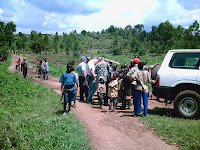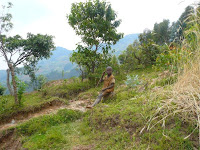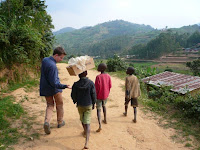,
 This is the first of 3 blog posts in which I will try to explain very briefly my view of what “Sustainable Development” is, based on my experiences in Rwanda.
This is the first of 3 blog posts in which I will try to explain very briefly my view of what “Sustainable Development” is, based on my experiences in Rwanda.
The buzzword of the decade is “Sustainable Development”: development that is environmentally socially and economically sustainable. The days of environmental exploitation, rollercoaster-capitalism and social exclusion need to end if we are to survive. We need to protect the environment, manage our economies better and help the poor.
What does sustainability mean for development aid projects? The answer of many of my colleagues in development would be something like this:
Development Aid is sustainable when the results achieved remain indefinitely, without destroying the environment, becoming unprofitable or causing social problems.

Sounds reasonable. If for example, we train 10 fishermen to fish better, those 10 fishermen continue to fish better after the training project has ended. Ideally, the fishermen pass on the better fishing methods to their children. And also, to ensure that their lake is not over-fished, they create a cooperative to manage fishing rights.
Unfortunately, things are not that simple in reality. The sustainability of the project will be threatened by three types of challenges:
- Maintenance: people will need to be retrained, cooperatives need to be revitalised and new fishing equipment needs to be maintained. An intelligently planned project can generally reduce this problem.
- Changes in the market: If the regional fish price collapses, if fishes migrate or people start eating less fish, the fishermen will have to respond to the changed situation. For many, this will mean finding a new occupation. Whilst the project might teach people to fish better, it doesn’t necessarily teach people how to look for vocational training by themselves.
- Population and demand growth: As the population and the economy grows, so will the needs of the people. People will need to further improve the efficiency of their fishing methods. But people will also need to find other occupations and create new industries. Basically, we don’t need to train fishermen, but micro-businessmen who will fish whilst it is profitable, and who will constantly look for new and better opportunities.
Basically, the problem is one of a constantly changing, dynamic and independent society. People will only succeed if they don’t need help from the outside to respond to such developments. There needs to be constant innovation, improvements, entrepreneurship and development for any improvement to be sustainable.
Our re-definition of sustainability could look something like this:
Development aid is sustainable when it leaves behind an independently functioning society and economy is able to develop and respond to future environmental, social and economic challenges.
 In my last post, I concluded:
In my last post, I concluded:
 A poorly designed development aid project would be one that counter-acts this development. For example, if a country has a growing private textiles industry (phase 3) and a donor brings in free clothes to distribute to the poor (phase 1), then this will damage or even destroy the local clothes and textiles businesses.
A poorly designed development aid project would be one that counter-acts this development. For example, if a country has a growing private textiles industry (phase 3) and a donor brings in free clothes to distribute to the poor (phase 1), then this will damage or even destroy the local clothes and textiles businesses.


